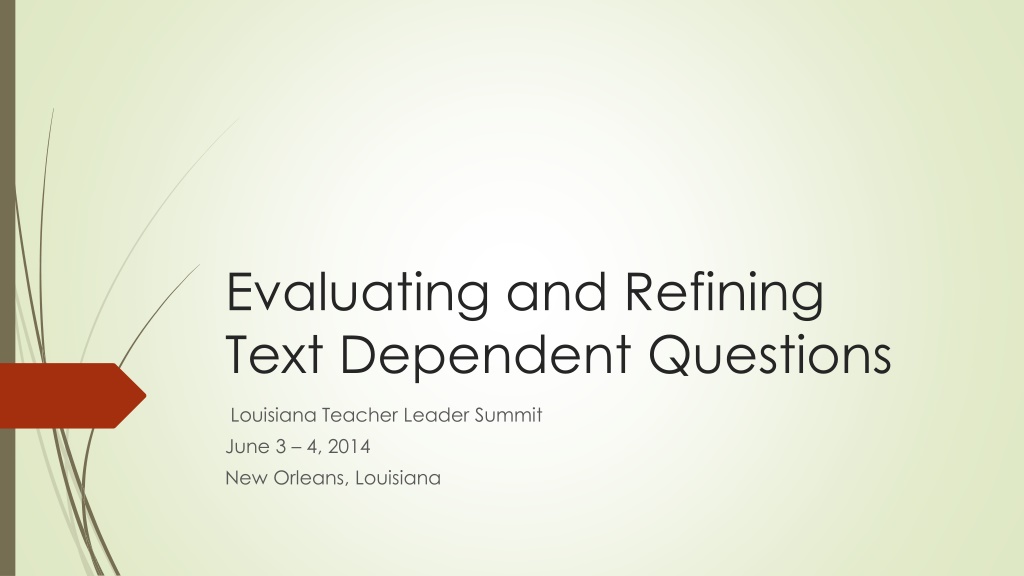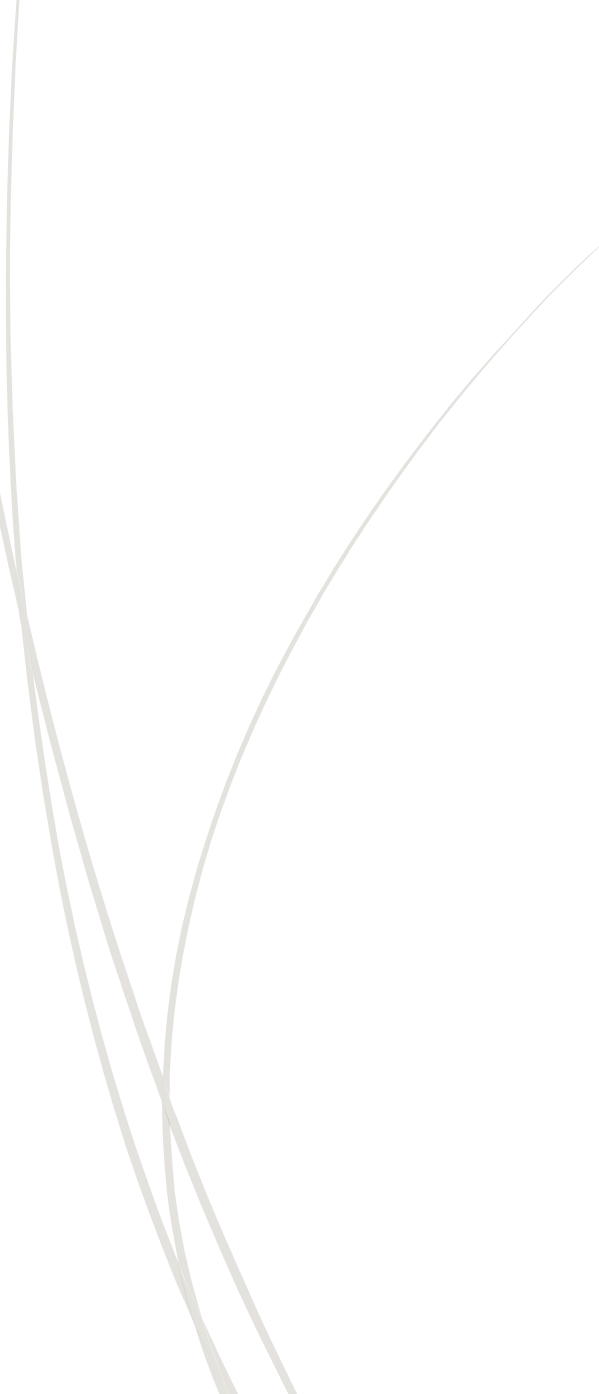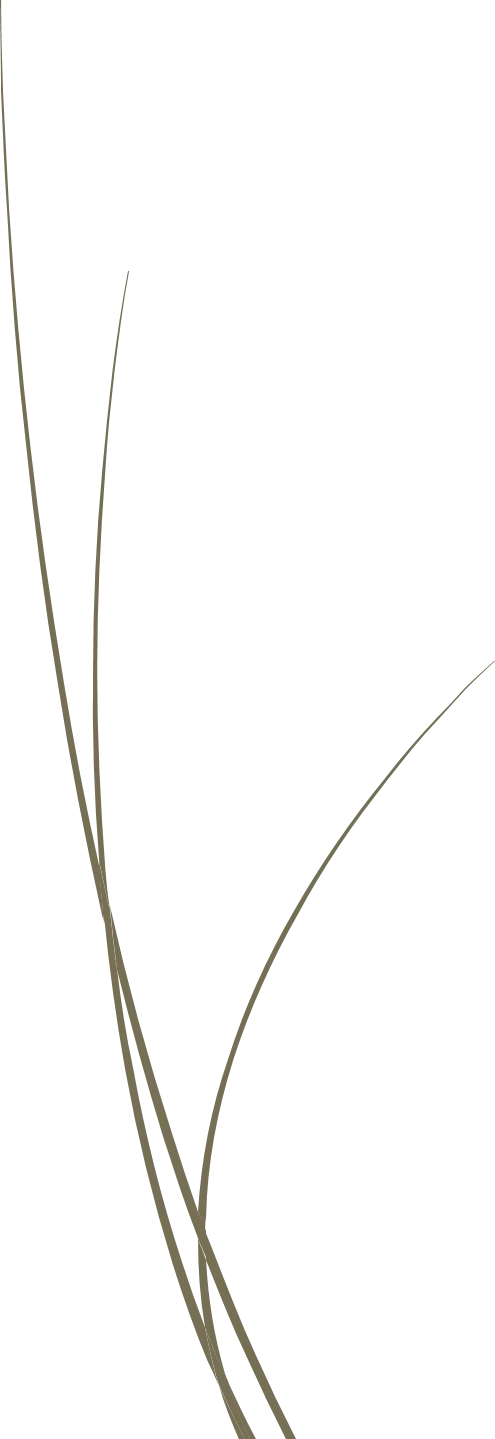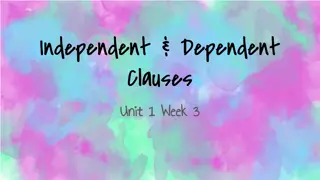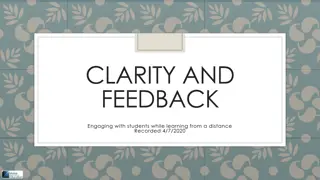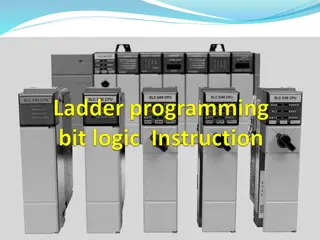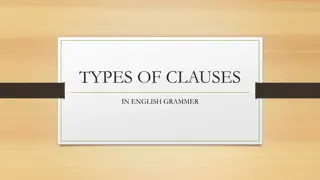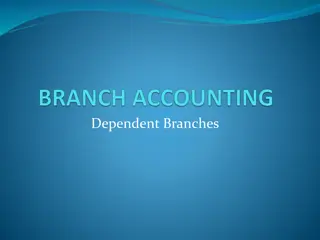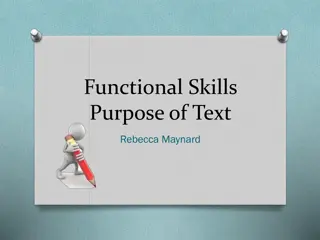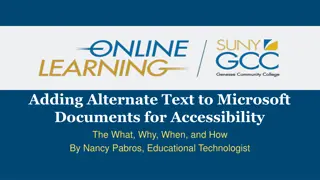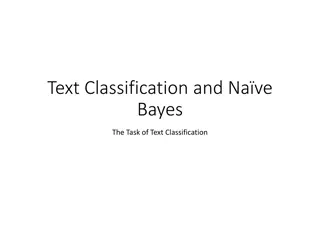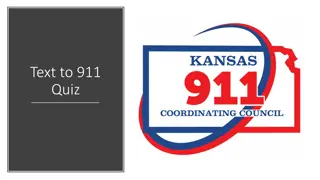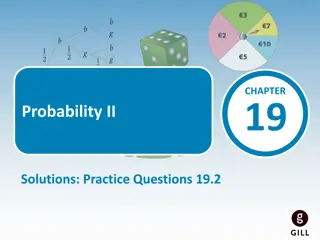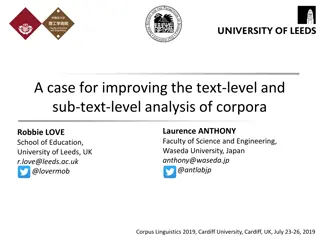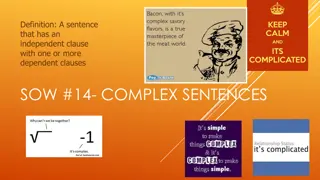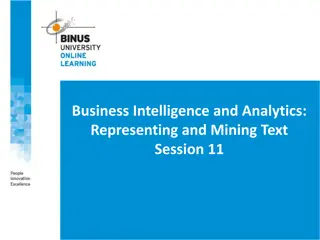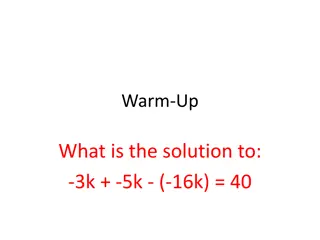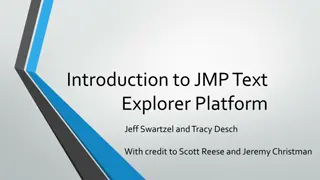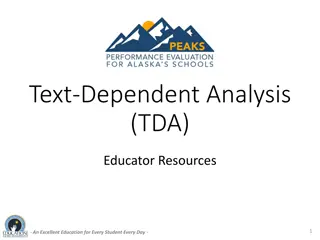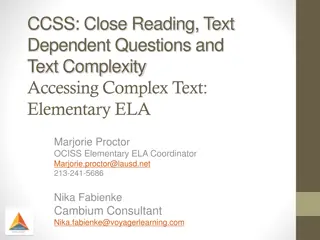Enhancing Text Dependent Questions for Effective Learning
Explore the significance of Text Dependent Questions (TDQs) in educational settings by reviewing their construction, alignment with CCSS, and importance in promoting deeper understanding of texts. Learn why evaluating and refining TDQs is crucial for enhancing students' comprehension and engagement with complex text materials.
Download Presentation

Please find below an Image/Link to download the presentation.
The content on the website is provided AS IS for your information and personal use only. It may not be sold, licensed, or shared on other websites without obtaining consent from the author. Download presentation by click this link. If you encounter any issues during the download, it is possible that the publisher has removed the file from their server.
E N D
Presentation Transcript
Evaluating and Refining Text Dependent Questions Louisiana Teacher Leader Summit June 3 4, 2014 New Orleans, Louisiana
What are we doing here? Session Objectives Review what makes a question text dependent and why it s important Review why the text itself is the first step Evaluate the quality of TDQ s for their value, text dependency, and alignment to the CCSS Revise TDQ s to be valuable in support of a text s key understanding(s)and aligned to the CCSS
What is a Text Dependent Question(TDQ)? Text dependent questions, as the name suggests, asks students to provide evidence from the text and draw inferences based on what the text says. Well-constructed text dependent questions cause students to reflect on the text as opposed to reading quickly to get the gist of the selection. A Primer on Close Reading of Text The Aspen Institute Education and Society Program
Why Text Dependent Questions (TDQs)? The Common Core State Standards for reading strongly focus on students gathering evidence, knowledge, and insight from what they read. Indeed, eighty to ninety percent of the Reading Standards in each grade require text dependent analysis; accordingly, aligned curriculum materials should have a similar percentage of text dependent questions. Long Guide to Creating TDQ s Anthology Alignment Project Edmodo Group Folder
Why is it important to evaluate TDQs? Judging the quality of the questions Time (efficiency)- prioritizing the most important questions and customizing the lesson for each unique group of students Plan for giving students information in addition to the text what will students glean over multiple readings? What do my students still need to know to comprehend the big idea of the text (that is not available in the text)?
The first step in evaluating TDQs involves Text Complexity while it is important for students to be able to comprehend both explicit and implicit material in texts, as well as to understand how various textual elements (such as main ideas, relationships, or generalizations) function in a text, the clearest differentiator in reading between students who are college ready and students who are not is the ability to comprehend complex texts. ACT released a study showing the importance of grade-level text: http://www.act.org/research/policymakers/pdf/reading_summary.pdf
TDQs: Checking Item Quality Does the question have value and is it worthy of students time? Is the question text dependent, requiring understanding of the text and the use of textual evidence? Is the question aligned to and reflective of the rigor of the CCSS?
The TDQ has Value Focuses on the key ideas (BIG ideas or central message), asks the questions that beg to be asked Targets essential academic language (words and phrases) that connect to key ideas Focuses on difficulty/important features of the text (e.g. complex syntax or complexity features that challenge students comprehension of the text) Allows students to show insights about the text
TDQ is really Text Dependent Demands close reading of the text, does not privilege prior knowledge Requires students to use evidence from the text Allows for synthesis within or between texts The sequence of the TDQ s keeps students focused on the text and helps them to gradually learn from it
Is the question Text Dependent? Valuable? Tim Shanahan released Letting the Text Take Center Stage highlighting similar findings: http://www.aft.org/pdfs/americaneducator/fall2013/Shanahan.pdf
Is there CCSS Alignment? Stays true to the intent of the standards Uses the language of the standards when possible or scaffolds to it Reflects the complexity and range of the standards Aligns to standards 1 (evidence) and 10 (complexity)
Match the TDQ to the CCSS standard(s) Read the following questions and determine which CCSS reading standard(s) is/are supported by that TDQ. Work with a friend or friends and justify your answers. http://www.corestandards.org/assets/CCSSI_ELA%20Sta ndards.pdf
The question is aligned to which CCSS standard(s)? First Grade, Informational TDQ from RAP Lesson The Moon, Eye on the Universe On page 19, why did the author give the bottom paragraph the title Big Red? Use evidence from the text to explain your answer. Tenth Grade, Literature TDQ from AAP Lesson Contents of a Dead Man s Pocket On page 18, a second setting is revealed. What is it and how does the writer use this setting to create suspense? Use evidence from pages 18 and 19 to support your answer.
.Sixth Grade, Literature EAGLE How Yugong Moved the Mountains Part A Which sentence best states a theme of the myth about Yugong? A. Hard work will always end in success. B. A wise man will always know his limitations. C. Old age is the time to follow one s fondest dreams. D. Great determination is required to accomplish great deeds. Part B Which sentence from the passage best supports the answer to part A? A. We shall create a new road down to the village. (paragraph 2) B. They dug and shoveled all day long and never stopped for rest. (paragraph 5) C. Even if I were no longer able to work, my children would, and their children after them . . . . (paragraph 8) D. The emperor called forth two might gods and told them to lift the mountains far away from Yugong shouse. (paragraph 10)
Before we continue, please consider Some easy, go-to TDQ s are developed purposefully to engage students with an easy beginning task. That is the teacher s decision and is actually not a bad idea. Some TDQ s that seem to be below CCSS grade level may be part of a scaffolded set, where the question is developed purposefully to be easy and the next question(s) builds toward the grade level CCSS and more complex idea(s). Use your knowledge of your students when developing, evaluating and revising TDQ sets.
Does the question support the Big Idea? Read the essential understanding and the following questions. Which questions support the big idea? Are any less essential? Third Grade BAP Lesson for a play adapted from Charlotte s Web Key understanding: You are never too small to do great things. -What is the setting of the play Charlotte s Web? -How does Charlotte change how she sews her web once she meets Wilbur and becomes determined to save her? -Homer says, A miracle has happened on the farm . What miracle has Charlotte performed? -How did Charlotte s idea solve Wilbur s problem? -Write an essay explaining what makes Charlotte no ordinary spider . How do these special qualities help Wilbur? Use evidence from the story to support your answer.
Does the question support the Big Idea? Read the essential understanding and the following questions. Which questions support the big idea? Are any less essential? Third Grade BAP Lesson for a play adapted from Charlotte s Web Key understanding: You are never too small to do great things. -What is the setting of the play Charlotte s Web? -How does Charlotte change how she sews her web once she meets Wilbur and becomes determined to save her? -Homer says, A miracle has happened on the farm . What miracle has Charlotte performed? -How did Charlotte s idea solve Wilbur s problem? -Write an essay explaining what makes Charlotte no ordinary spider . How do these special qualities help Wilbur? Use evidence from the story to support your answer.
Does the question support the Big Idea? Is the question text dependent and aligned to the grade level CCSS? Fourth Grade BAP Lesson for the poem The Midnight Ride of Paul Revere Big Idea: Knowing the importance of sacrificing and taking risks for freedom, a determined person can accomplish great things. Question: What is the poem's setting? Which phrase from the poem is a clue that the setting is the Revolutionary War? Is the setting important to comprehending the key understandings of the poem? Is the question text dependent? Is the question aligned to the 4th grade ELA/Literacy CCSS? Could this question be refined?
Evaluate the Question Read the fable The Ant and the Grasshopper found at http://www.aesopfables.com/cgi/aesop1.cgi?1&TheAnta ndtheGrasshopper&&antgrass2.ram Evaluate the following question for value to comprehending the key understanding text dependent aligned to third grade level CCSS. Who are the characters in the fable The Ant and the Grasshopper ?
Refining the Question Who are the characters in the fable The Ant and the Grasshopper ? How can we refine this question for 3rd grade CCSS and also make it more valuable and text dependent?
Refined TDQ RL.3.3: Describe characters in a story (e.g., their traits, motivations, or feelings) and explain how their actions contribute to the sequence of events. Who are the characters in the fable The Ant and the Grasshopper ? Sample refined TDQ s: What can we learn about the grasshopper and the ant in the first paragraph of the fable? Use details from the fable in your answer. Reread the first sentence in the last paragraph of the fable. What does the grasshopper think about what the ant is doing?
Want more practice? Are you a CCSS nerd? Take the time to research and teach with lessons from Student Achievement Partners www.achievethecore.org and Edmodo RAP, BAP and AAP Work collaboratively with other educators at your school, district or join other groups Attend a training and submit lessons for review with Student Achievement Partners Volunteer to work on district and state committees, task forces, and work groups
Edmodo Group Codes for: BAP (Basal Alignment Project) f4q6nm AAP (Anthology Alignment Project) jsv4r7 RAP (Read Aloud Project) pkx52i
One more little thing. What about PARCC? How can we prepare our students for PARCC? Take the practice tests http://practice.parcc.testnav.com/# Engage our students with questions that are aligned with the CCSS, use its language, are valuable and text dependent, as well as being developed specifically to support students in gradually unveiling the key understanding(s)of a complex text. Make certain question and task structures are routine
Resources and References http://www.act.org/research/policymakers/pdf/reading_summary. pdf http://www.aft.org/pdfs/americaneducator/fall2013/Shanahan.pdf http://www.aspeninstitute.org/publications/implementing- common-core-state-standards-primer-close-reading-text www.achievethecore.org www.louisianabelieves.com http://parcconline.org/ EAGLE training, LDOE, Summer 2013.
Questions, comments, nice things to say.. Sam Johnson Tangipahoa District Literacy Specialist Sam.Johnson@tangischools.org
Additional Practice, Time Providing Read the following questions taken from ReadWorks. Are the questions valuable, text dependent and aligned to the CCSS? Can the question(s) be edited or refined to become valuable, text dependent and aligned to the CCSS?
Additional Practice Seventh Grade: Read the following paragraph, written from Abraham s point of view. The man came closer and raised his stick to his shoulder. From the stick came a flash of light and a booming sound that scared Abraham. The elephant felt something hot hit his shoulder. The man took a few steps forward, raised the stick again, and Abraham felt another hot jolt, this time on his ribs. Based on the description above, what kind of stick was the man really holding? A a club B a sword C a spear D a gun
Additional Practice Is stick a valuable vocabulary word to this passage or is it trivial? (we may need to guess a bit as we have not read the passage in its entirety) Is this question text dependent? Would I need to read the passage to answer the question about the meaning of stick as used in the passage? Is the question aligned to the seventh grade RL standards?
Additional Practice Taken from the same passage: 1. Who is Abraham? A a trainer B an elephant C a rice farmer D a circus ringmaster
Additional Practice Who is Abraham? Is this question text dependent? Is it valuable or trivial? Is this question aligned to the 7th grade CCSS? Can the question be refined or should it be replaced/deleted?
